Upgrading Analog ATEs
 At some point, virtually every company finds itself in a situation when the existing digital (or analog) PBX becomes a bottleneck in the company’s business communications. This is usually the case when the management and the IT department start considering its complete replacement or upgrading.
At some point, virtually every company finds itself in a situation when the existing digital (or analog) PBX becomes a bottleneck in the company’s business communications. This is usually the case when the management and the IT department start considering its complete replacement or upgrading.
Many companies face situations when the existing analog PBX fails in completing set tasks and gradually becomes mentally and physically obsolete. In this scenario, the matter of its upgrade pops up.
The most common symptoms include:
- No more unused ports left. There is nowhere to connect new hires.
- Call recording is required. The PBX can’t record calls.
- You need call center functionality or an automatic dialing system for the sales and marketing department. The current PBX does not have such functionality.
- You need call analytics for internal accounting.
- Limited features. VoIP telecom carriers or calls from the website can’t be connected.
- The number of external lines does not allow accepting all calls from the customers; this may lead to situations when some customers just can’t get through to the company.
- You need to connect your telephony to the CRM system’s server, but the PBX was not designed for this.
- The company creates regional branches but can’t connect them to the central telephone exchange.
- PBX is obsolete, boards or spare parts are no longer released for it. Failure of any node will lead to the shutdown of the entire company’s operation.
Most often, PBX is upgraded using one of these methods:
- Integrating Asterisk and the existing PBX.
- Replacing the existing PBX with analog gateways. Retaining telephone wiring and phone sets.
- Replacing the existing PBX with Asterisk IP PBX and IP phones.
Integrating Asterisk and the Existing PBX.
This option is based on the classic upgrading scheme, where Asterisk is installed separately for telephony providers and the existing PBX. All call handling features are migrated to Asterisk. The existing PBX becomes a “hub” with phones connected to it but is in no way involved in smart call processing.
“Provider-Asterisk-Analog PBX” scheme
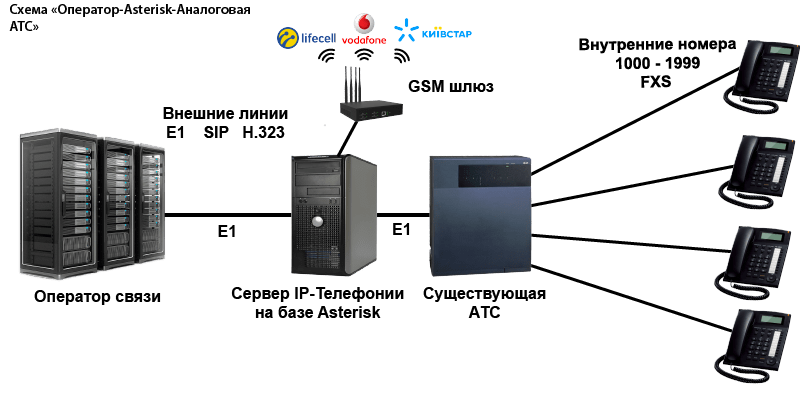
Upgrading analog PBX
Scheme: “Provider-Asterisk-Analog PBX” + connecting IP phones to Asterisk
The user base is subsequently expanded using Asterisk. Asterisk can connect both IP phones and other VoIP devices.
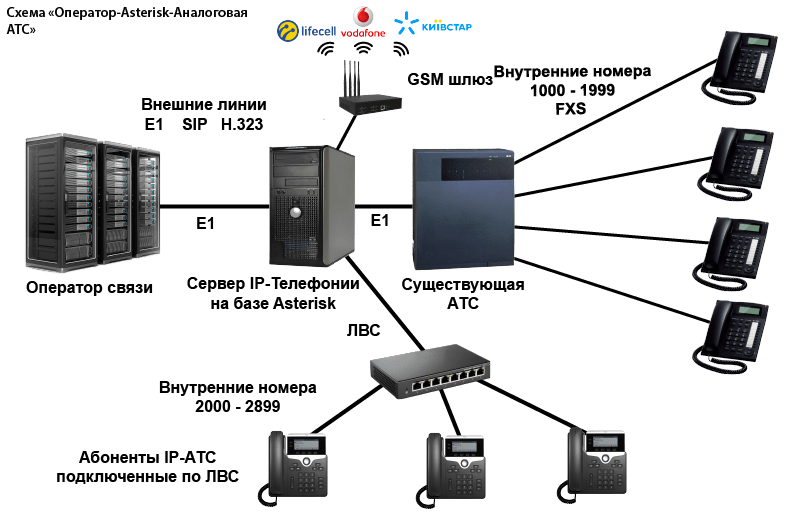
Scheme: “Provider- Asterisk-Analog PBX” – IP phones + remote company locations
IP PBX in the head office will be able to connect all remote locations: branches, stores, warehouses, manufacturing facilities, and so on. And on top of that, off-site employees, too. All users will be able to call each other for free by dialing just three digits of the extension number.
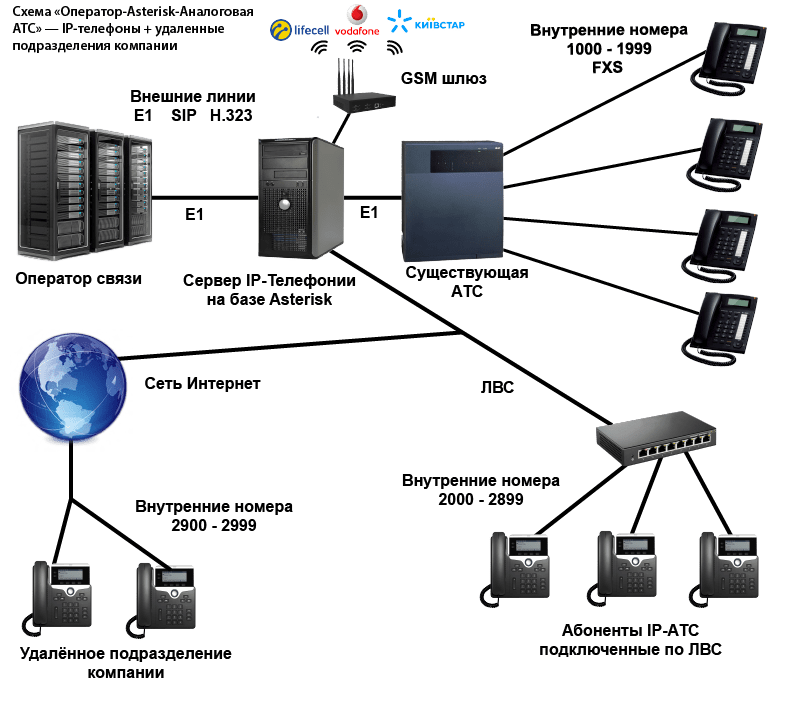
Integrating analog PBX and Asterisk + remote locations
Scheme: “Provider Asterisk-Analog PBX” – IP phones + remote company locations + IP telephony provider
When this scheme is used, in addition to IP phones, a VoIP provider can be connected offering additional channels, providing numbers from other cities, 8-800 number, Skype account and call from the website button.
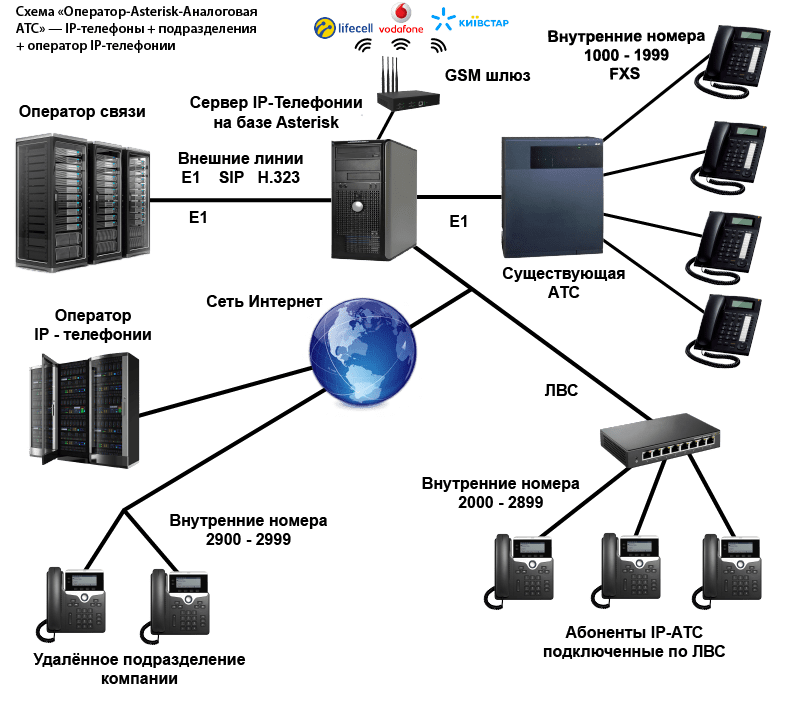
Integrating the old analog exchange and Asterisk SIP
2. Replacing the Existing PBX with Analog Gateways. Retaining Telephone Wiring and Phone Sets.
In this case, the company abandons the PBX by disconnecting it altogether. Instead, Asterisk server and analog line gateways are installed. Every gateway is designed for 30 extension lines and the number of installed gateways is unlimited. Analog phones are connected directly to gateways.
“Provider- Asterisk-Analog PBX” scheme
Instead of PBX, a required number of gateways is connected, to which analog users will then be connected. PBX functionality will be migrated to Asterisk.
The wiring is retained. Users don’t notice the upgrade. The numbering capacity can be expanded indefinitely.

Replacing analog PBX with Asterisk
Scheme: “Provider- Asterisk-Analog PBX” + expansion using IP phones
In addition to features of the previous scheme, new users here are connected using IP phones. This does not require laying wires, as every IP phone is equipped with a LAN switch that allows the IP phone and the computer to use the same LAN cable. Analog users can make calls to IP phones with no actual differences between the users.
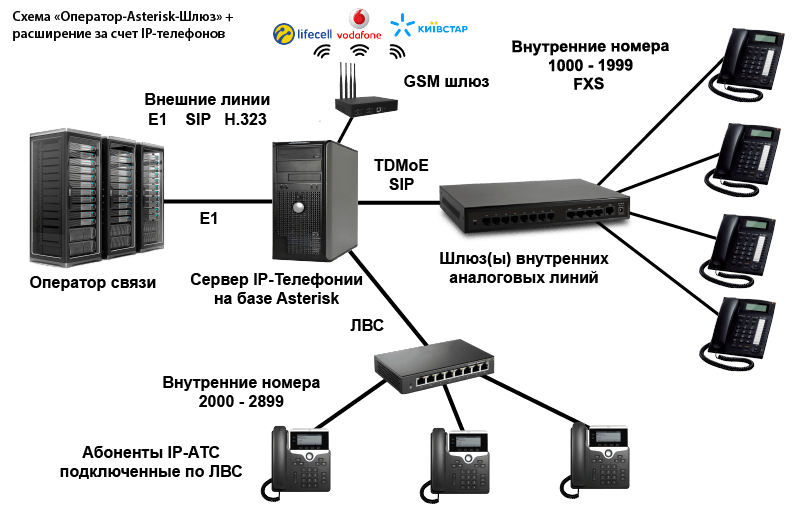
Replacing analog PBX with a gateway
Scheme: “Provider- Asterisk-Gateway” + IP phones + Connecting remote locations
Additionally, IP PBX in the head office will be able to connect all remote locations: branches, stores, warehouses, manufacturing facilities, and so on. And on top of that, off-site employees, too. All users will be able to call each other for free by dialing just three (or four) digits of the extension number.

Upgrading analog PBX
Scheme: “Provider Asterisk-Gateway” – IP phones + Company locations + IP telephony provider
When this scheme is used, in addition to IP phones and remote company locations, a VoIP provider can be connected offering additional channels, providing numbers from other cities, 0-800 number, Skype account and call from the website button.

3. Replacing the Existing PBX with Asterisk IP PBX and IP Phones.
“Provider- Asterisk” scheme
All phone sets are replaced and the PBX is being replaced with the Asterisk IP telephony server. Extension users are connected via LAN. Every employee has the maximum set of possible IP telephony features.
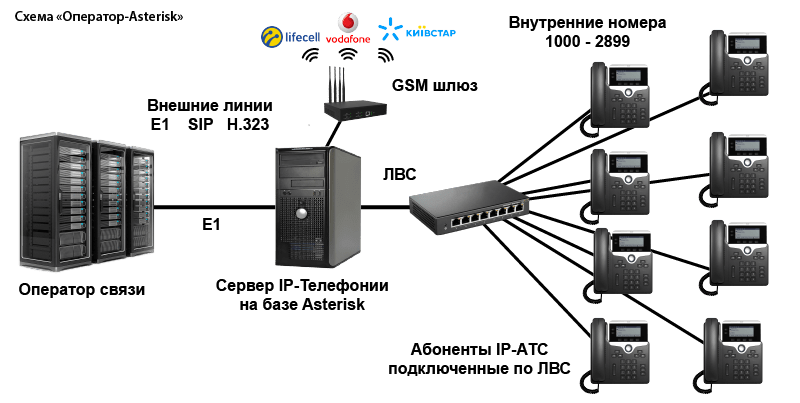
Replacing the existing PBX with Asterisk IP PBX
Scheme: “Provider-Asterisk” + connecting IP telephony provider
To save cost on calls to the Russian Federation and abroad, it is possible and advisable to connect the IP telephony provider. Moreover, the provider may connect additional numbers.
 Scheme: “Provider-Asterisk” – IP telephony provider + Company locations
Scheme: “Provider-Asterisk” – IP telephony provider + Company locations
In addition to the previous scheme, remote company locations are connected via the Internet: branches, stores, warehouses, partner ATEs and others. All users of the unified network get the opportunity to call each other for free using short extension numbers.

Original article: https://voxlink.ru/services/old-pbx-upgrade/
Category:IP PBXNon-categorized



